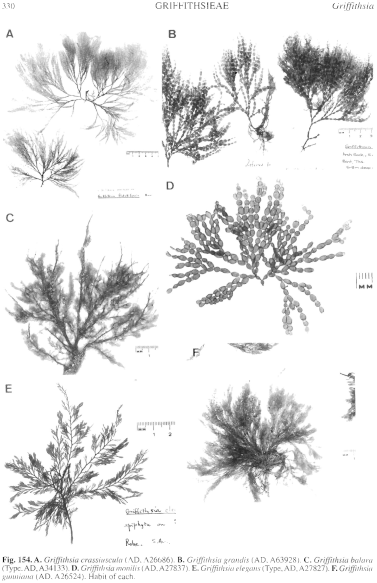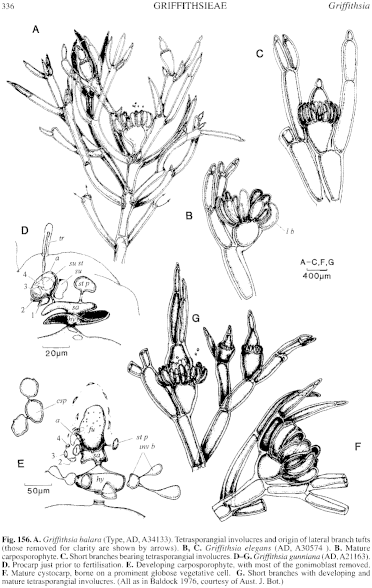|
|
|
|
|
|||||||||||
|
Electronic Flora of South Australia Species Fact Sheet
Phylum Rhodophyta – Order Ceramiales – Family Ceramiaceae – Tribe Griffithsieae
Thallus (Fig. 154C) light to dark red, 8–14 cm high, irregularly branched with long axes bearing whorled laterals of limited growth, densely clothed below with anastomosing rhizoids. Attached by rhizoids; epilithic. Structure. Axial cells cylindrical, 350–410 µm in diameter and L/D 2.5–4.5, most bearing from their upper shoulders a whorl of 4 lateral subdichotomous tufts (Fig. 156A) produced sequentially and branched 1–3 times, occasionally bearing whorls of 4 laterals, the basal cells narrow-cylindrical, swollen distally, 180–210 µm in diameter and L/D 7–9; filament apices narrowing markedly, apical cells conical. Rhizoids robust, unbranched, arising from the lower parts of axial cells, intermingling with laterals and forming characteristic rope-like masses 7–12 mm in diameter.
Reproduction: Gametophytes unknown.
Tetrasporangia globose, 50–70 (–90) µm in diameter, produced successively in groups of 3–6 on fascicles consisting of 1 (–2) minute, terete cells developed in masses from the shoulders of inflated cells of long axes and from the subapical cells of many lateral branch tufts (Fig. 156A), tetrahedrally divided; apical cell above each mass of fascicles becoming ovoid, and producing a narrow filament of 1–2 cells that rarely divides subdichotomously; vegetative cell bearing the fascicles enlarging greatly, becoming pyriform, 530–700 µm in diameter and producing from its upper shoulders a whorl of 16–18, incurved, 1-celled branches 130–150 µm in diameter and L/D 2.5–5, enclosing the masses of fascicles in a palisade-like involucre; vegetative filament above mature fascicles commonly lost, resulting in a cupulate structure.
Type from Hopetoun, W. Aust. (Gordon, 20.xi.1968); holotype in AD, A34133.
Distribution: Known only from the type locality and W of Flinders I., S. Aust., 32 m deep (Branden, 21.vi.1988; AD, A59308).
This species superficially resembles Halurus, a European member of the Griffithsieae, and Anotrichium towinna in the rope-like thallus base, irregularly branched main axes and whorled laterals. The masses of minute tetrasporangial fascicles in the constriction between vegetative cells and involucres consisting of whorls of 1-celled branches produced from the upper shoulders of vegetative cells bearing the fascicles clearly place G. balara in the G. antarctica group of Griffithsia.
References:
BALDOCK, R.N. (1976). The Griffithsieae group of the Ceramiaceae (Rhodophyta) and its southern Australian representatives. Aust. J. Bot. 24, 509–593.
The Marine Benthic Flora of Southern Australia Part IIIC complete list of references.
Publication:
Womersley, H.B.S. (24 December, 1998)
The Marine Benthic Flora of Southern Australia
Rhodophyta. Part IIIC. Ceramiales – Ceramiaceae, Dasyaceae
©State Herbarium of South Australia, Government of South Australia
Illustrations in Womersley Part IIIA, 1998: FIGS 154C, 156A.

Figure 154 enlarge
Fig. 154. A. Griffithsia crassiuscula (AD, A26686). B. Griffithsia grandis (AD, A63928). C. Griffithsia balara (Type, AD, A34133). D. Griffithsia monilis (AD, A27837). E. Griffithsia elegans (Type, AD, A27827). F. Griffithsia gunniana (AD, A26524). Habit of each.

Figure 156 enlarge
Fig. 156. A. Griffithsia balara (Type, AD, A34133). Tetrasporangial involucres and origin of lateral branch tufts (those removed for clarity are shown by arrows). B, C. Griffithsia elegans (AD, A30574 ). B. Mature carposporophyte. C. Short branches bearing tetrasporangial involucres. D–G. Griffithsia gunniana (AD, A21163). D. Procarp just prior to fertilisation. E. Developing carposporophyte, with most of the gonimoblast removed. F. Mature cystocarp, borne on a prominent globose vegetative cell. G. Short branches with developing and mature tetrasporangial involucres. (All as in Baldock 1976, courtesy of Aust. J. Bot.)

|
Email Contact: State Herbarium of South Australia |

|